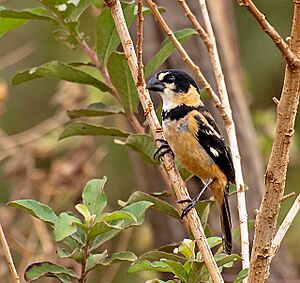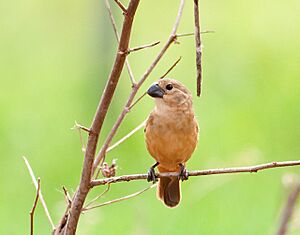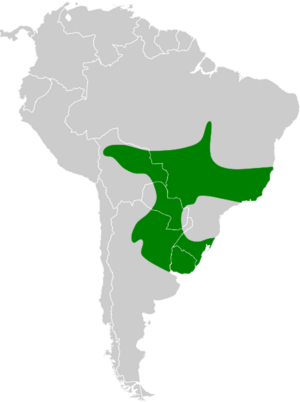Rusty-collared seedeater facts for kids
Quick facts for kids Rusty-collared seedeater |
|
|---|---|
 |
|
| Male in São Paulo, Brazil | |
 |
|
| Female in São Paulo, Brazil | |
| Conservation status | |
| Scientific classification | |
| Genus: |
Sporophila
|
| Species: |
collaris
|
 |
|
The rusty-collared seedeater (Sporophila collaris) is a small bird. It belongs to the Thraupidae family. This family includes many colorful birds, often called "tanagers". Before, it was thought to be part of the Emberizidae family, which are mostly sparrows and buntings.
This bird lives in South America. You can find it in countries like Argentina, Bolivia, Brazil, Paraguay, and Uruguay. It likes to live in open areas. These include grasslands that get wet or flooded sometimes. It also lives in swamps and areas where forests used to be.
Contents
What is a Rusty-collared Seedeater?
The rusty-collared seedeater is a small, seed-eating bird. Males have a bright rusty-orange band around their neck. This is how they get their name. Females are usually duller in color. They are mostly brownish-yellow. These birds are known for their sweet songs. They often sing from tall grasses or bushes.
Where Do They Live?
Rusty-collared seedeaters prefer specific places. They like open fields and grassy areas. These habitats are often found near water. Swamps and wet grasslands are perfect for them. They also live in areas where forests have been cleared. This shows they can adapt to changes in their environment.
Naming the Rusty-collared Seedeater
The rusty-collared seedeater has a long history. A French scientist, Georges-Louis Leclerc, Comte de Buffon, wrote about it in 1775. He included it in his big book, Histoire Naturelle des Oiseaux. This book was about all kinds of birds.
How It Got Its Scientific Name
The bird was also drawn by François-Nicolas Martinet. His drawings were in a book called Planches Enluminées D'Histoire Naturelle. This book went with Buffon's text. In 1783, a Dutch scientist named Pieter Boddaert gave the bird its first scientific name. He called it Loxia collaris.
Buffon first thought the bird came from Angola. But in 1904, an Austrian bird expert, Carl Eduard Hellmayr, corrected this. He said the bird's true home was Rio de Janeiro in Brazil.
The Modern Name
Today, the rusty-collared seedeater is in the Sporophila group of birds. This group was named by a German scientist, Jean Cabanis, in 1844. The name Sporophila comes from two old Greek words. Sporos means "seed," and philos means "loving." So, Sporophila means "seed-loving." The word collaris is Latin for "of the neck." This refers to the rusty band on the male bird's neck.
Types of Rusty-collared Seedeaters
Scientists have found three slightly different types, or subspecies, of the rusty-collared seedeater:
- S. c. ochrascen (named by Hellmayr in 1904): This type lives from Bolivia to south-central Brazil.
- S. c. collaris (named by Boddaert in 1783): This type is found in eastern Brazil.
- S. c. melanocephala (named by Vieillot in 1817): This type lives in southwest Brazil, Paraguay, and northern Argentina. It is also found in southeast Brazil and Uruguay.


